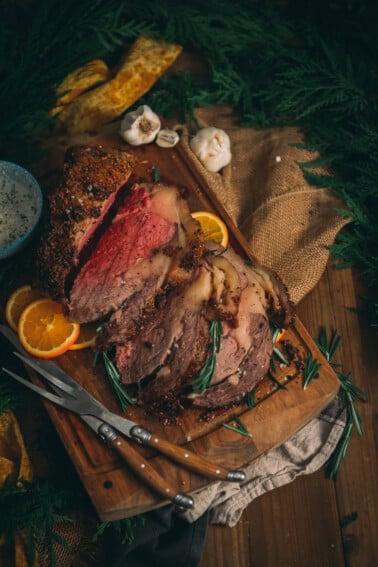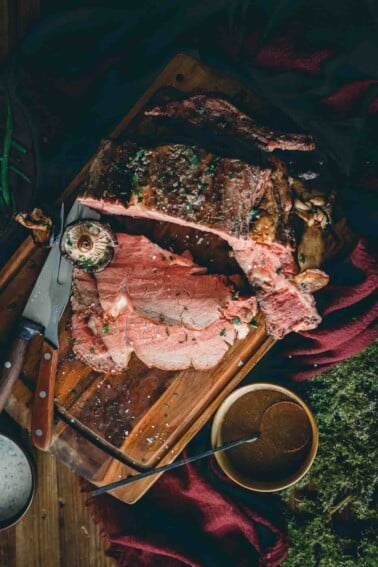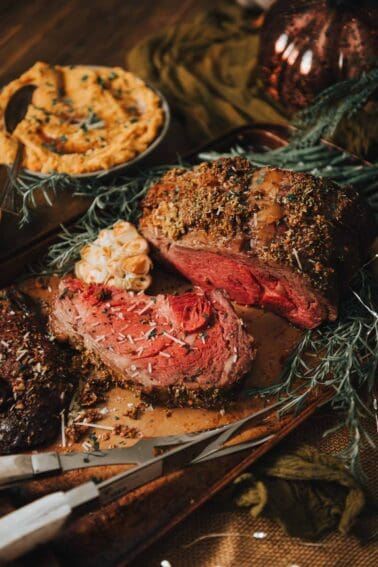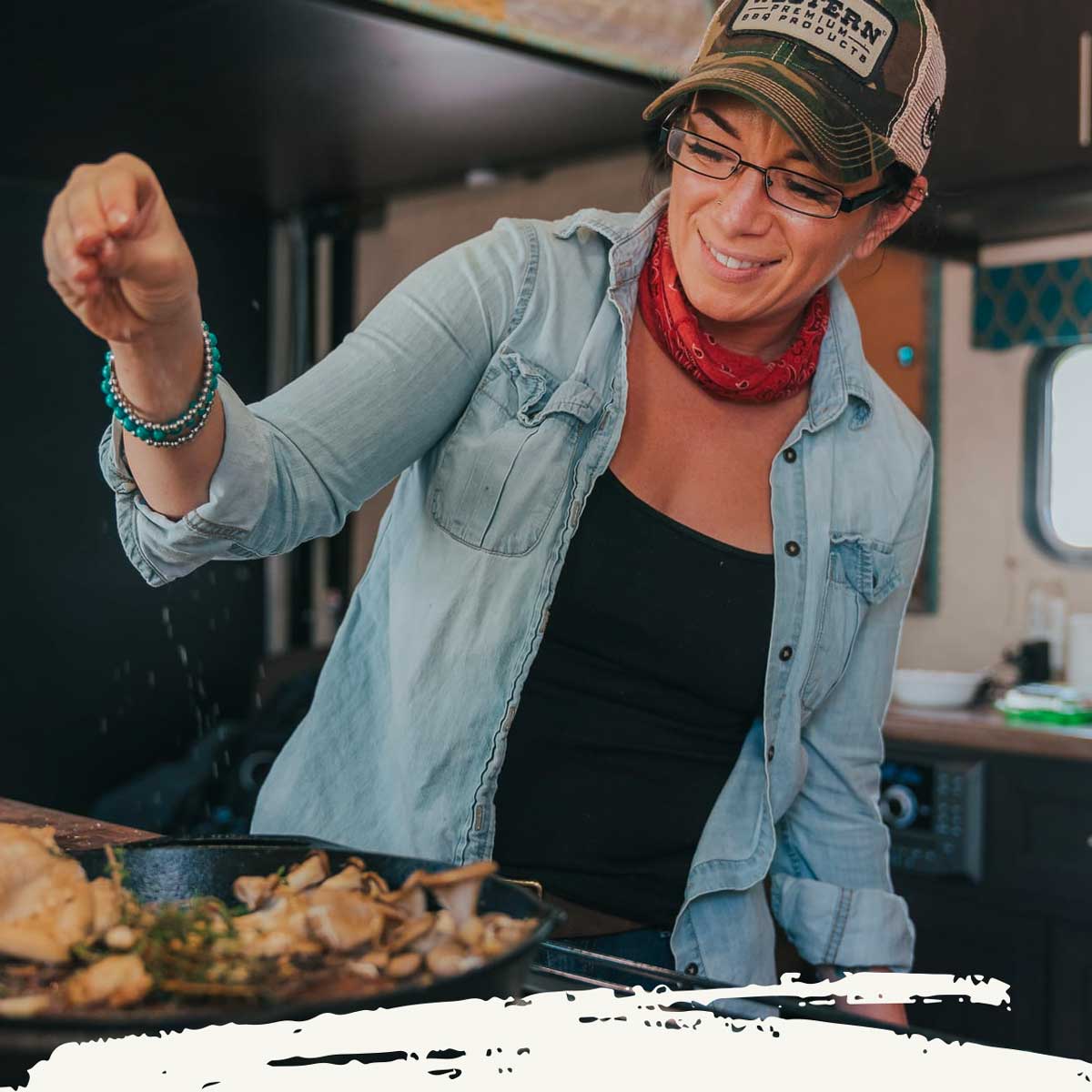Here’s what sets our method apart: low and slow smoking at 250°F for even cooking and unparalleled tenderness, finishing with a sear on all sides for a delicious, crispy crust, and providing adaptations for various grill types to ensure success no matter your setup.
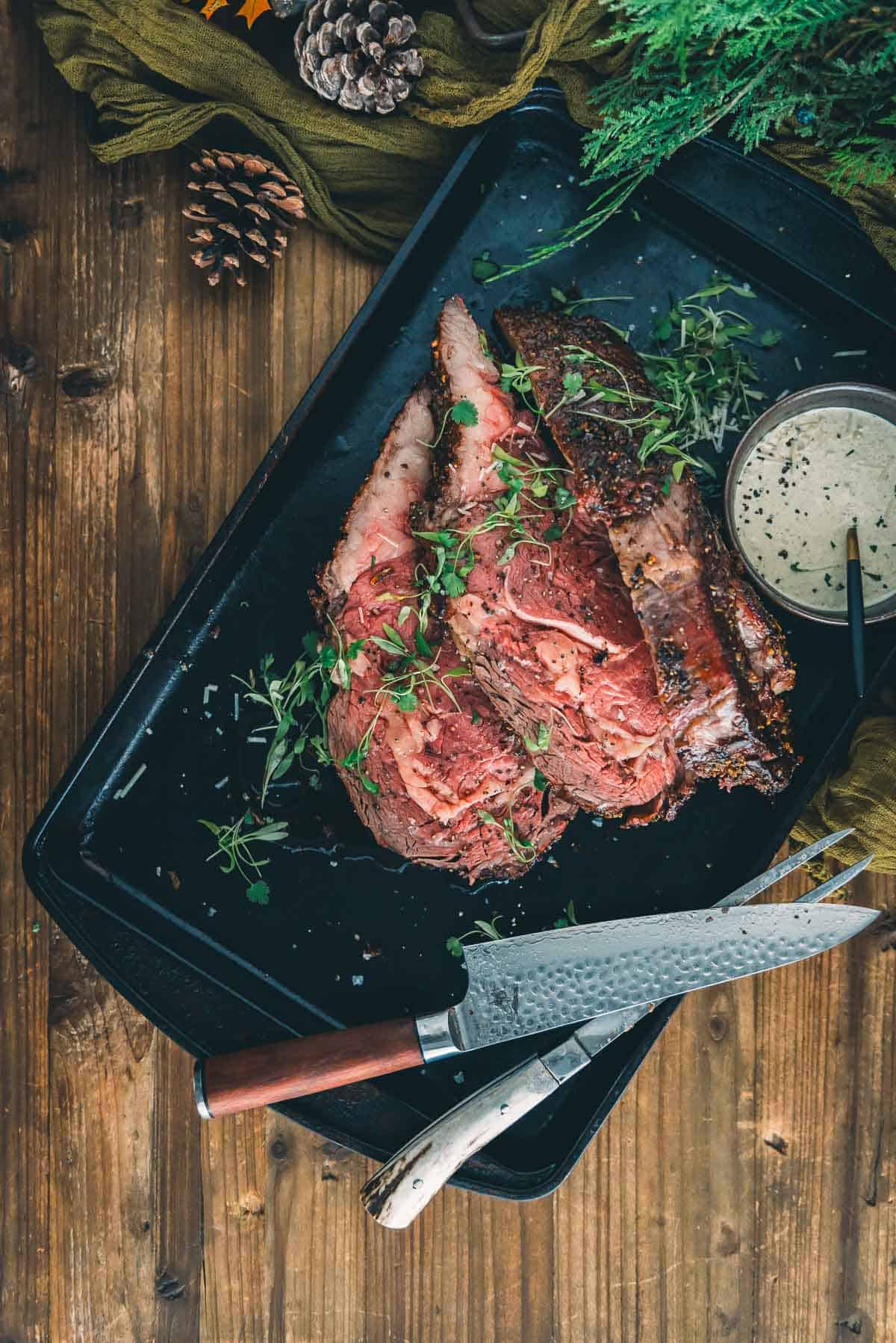
Table of Contents
- 🥩 The Cut: What is a boneless Rib Roast?
- Why Reverse Sear Prime Rib?
- Reverse Sear Prime Rib Recipe Ingredients
- How to Reverse Sear Rib Roast
- What’s temp do you cook a prime rib to?
- Prime Rib Reverse Sear Recipe Tips
- Prime Rib Verse Sear Recipe Variations
- How to Reverse Sear Prime Rib in the Oven
- Using a Gas Grill:
- Using a Charcoal Grill:
- Can I use a bone in prime rib?
- What to serve with a reverse seared prime rib
- Storing and Reheating Leftover Reverse Sear Rib Roast
- More juicy Prime Rib Recipes
- Reverse Sear Prime Rib Recipe Recipe
In this recipe:
If you love cooking show-stopping yet easy beef recipes, this reverse seared boneless rib roast is for you. Starting with a boneless roast lets you skip tricky carving and enjoy more meat per pound (and save a few dollars) this holiday season. First, gently smoke your roast in the grill or oven to get the inside perfectly medium-rare. Then, sear it in a hot cast iron skillet to develop an unbelievable crust you can’t wait to dig into.
This easy reverse-sear method means you’ll achieve the juicy interior and crispy exterior of your dreams with zero guesswork, whether it’s Christmas dinner or a special occasion. Just like the simplicity of sous vide prime rib but with the benefit of that smokey flavor. If you love cooking show-stopping yet easy holiday recipes, give this stunner a try. You’re going to wow everyone with your skills when you set this elegant roast on the table.

🥩 The Cut: What is a boneless Rib Roast?
A boneless rib roast is a large, impressive cut of beef from the rib section, simply without the bones. It’s the same tender, flavorful meat as a standing rib roast, just deboned by the butcher for ease of carving. We love to stock up on them when they are on sale around the holidays. Just pay attention to the grade of beef on the label and know the difference between Prime and Choice when you’re buying.
Pros:
- Easier to carve and serve without bones
- More meat per pound since there is no bone weight
- Less expensive because you’re not paying for the weight of the bones
- More overall surface area to sear for that delicious crust.
Cons:
- The meat dry out slightly faster without bone insulating the meat
- Less flavor from roasted bones
- The bones can act as a rack for the roast during cooking and make amazing beef broth later on
Why Reverse Sear Prime Rib?
The reverse sear method is perfect for cooking large cuts of meat like prime rib. First, the roast is gently cooked at a low temperature which evenly brings the inner meat to medium-rare doneness without overcooking the outer layers. Then it is seared at high heat to quickly develop a flavorful, caramelized crust on the exterior.
The benefits of reverse searing include even edge-to-edge cooking, the ability to get lots of seasoning on the meat, and a great sear without drying it out or scorching the meat. The low then high heat results in a tender interior and crispy exterior every time and is the perfect way to lock in the flavor of a grilled prime rib. It takes the guesswork out of roasting for that ideal steak doneness of medium-rare throughout.

Reverse Sear Prime Rib Recipe Ingredients
When it comes to roast beef, we love to keep it simple and let the taste of the meat shine through. We did an experiment and dry-aged this prime rib in the fridge for four days before cooking it.
- 4-5 lbs boneless rib roast – we stock up on these at our local grocery store when they go on sale at the holidays, or trim our own from a whole rib roast, or you can see our favorite places to buy meat online if you’re looking for a prime grade or wagyu.
- Kosher salt
- Oil
- Garlic seasoning – we use and LOVE JewCanQues Garlic Junkie Seasoning. A garlic heavy salt pepper garlic blend will work great, and Jack Daniel’s Steak Seasoning is a good second choice with a bold peppery bite of flavor.
How to Reverse Sear Rib Roast
Although this recipe looks complicated, it’s not. In fact, we bet you’ve been using similar techniques for years!
- Start by patting the rib roast dry with paper towels. If the fat cap is thicker than 1/4 inch, score it with a sharp knife to help the salt permeate deeper. Sprinkle all sides liberally with salt and place it on a wire rack over a baking sheet. Allow it to dry in the fridge for 24 to 48 hours. It will get a deep red color and a tough dry texture on the outside as it ‘dry ages’ in the fridge.
- When ready to cook, let the boneless prime rib come to room temperature on the counter for 1 – 2 hours. Slather it with oil and cover the entire roast in a liberal coating of the garlic spice blend. Meanwhile, prep your smoker for 250 degrees F. If using wood chips or smoking wood, we love post oak with this roast. If using a pellet smoker, try our favorite Jack Daniel’s charcoal pellets with chunks of oak or hickory in the back corners of your grill. We used our Traeger pellet grill for this boneless prime rib recipe.
- When the grill is ready, place the boneless prime rib roast on the grill grates, fat side up, and close the lid. Smoke the roast until the internal temperature is 120°F with a digital meat thermometer, or about 15 degrees F below where your desired internal temperature is. This took the 4 1/2 pound roast we showed in the pictures one hour.
- Using tongs, remove the roast from the grill grates and let it rest, tented with aluminum foil, on a rimmed baking sheet for 30 minutes. The internal temperature of the beef will continue to rise as it rests about 7 to 10 degrees. While the prime rib rests, increase the heat on the grill for a sear, getting the temp up to 450-500 degrees F.
- After the boneless rib roast has rested for 30 minutes, it’s time to sear it off to finish it. Place a cast iron skillet on the hottest part of the grill and preheat it until just smoking. Use a dry cast iron pan to get the full effect of the Maillard reaction for an insanely flavorful crust. Using long tongs, add the roast to the hot skillet and sear for 3 to 5 minutes per side, getting a good golden brown crust on all sides.
- Transfer to a clean cutting board and wait 5 minutes before slicing into individual portions, about 1/2″ thick, and serving. There’s no need to rest the meat again because it already rested before you seared it, which means, use a carving fork because these slices can be piping hot. Serve with a pinch of freshly ground black pepper, flakey salt, and homemade horseradish cream sauce or au jus for an iconic feast.
What’s temp do you cook a prime rib to?
For us, the perfect finished internal temperature is 135°F, medium rare for a prime rib in the center of the roast, after it’s rested and seared. We use an instant-read thermometer inserted into the thickest part of the roast to ensure accurate results and a perfect prime rib every time. Adjust the cooking time so you get your desired temp.


Prime Rib Reverse Sear Recipe Tips
- Even Temperature: Ensure your grill or oven maintains a steady temperature for the best results. Use a reliable thermometer to monitor the ambient temperature.
- Seasoning: Apply your rub generously and evenly to ensure every slice is packed with flavor. Allow the salt to penetrate the meat by seasoning early.
- Patience is Key: Allow the prime rib to cook slowly during the initial phase. This slow process ensures that the roast cooks evenly, preventing the outer layers from overcooking before the center reaches the perfect temperature.
How long to let Prime Rib rest before searing
Letting your prime rib rest before searing is crucial for two reasons: it allows the juices to redistribute throughout the meat, ensuring a moist and tender roast, and it brings the internal temperature up to the perfect point for a quick sear. Rest the prime rib for at least 30 minutes covered loosely with foil. This pause also gives you time to get your searing setup scorching hot for that perfect crust.
How long to Reverse Sear Prime Rib: Temperature Chart
To achieve the perfect doneness, use this temperature guide along with your meat thermometer:
- Rare: Remove at 115°F to 120°F, sear to finish at 125°F.
- Medium-Rare: Remove at 120°F to 125°F, sear to finish at 135°F.
- Medium: Remove at 130°F to 135°F, sear to finish at 145°F.
Each stage of cooking adds about 10°F during searing, so plan your removal accordingly to avoid overcooking. Adjust the initial slow-roasting temperature and timing based on the size of your roast and the specifics of your cooking setup.
Prime Rib Verse Sear Recipe Variations
How to Reverse Sear Prime Rib in the Oven
Similar to our classic roasted prime rib roast, this recipe starts with low heat and adds a sear at the end.
- Prep the roast as instructed in the recipe card, but when ready to cook, adjust the oven racks to the middle-low position to easily slide the roasting pan in and out. Then, preheat your oven temperature to 250 degrees F.
- After seasoning the roast, nestle it into a roasting rack and cook it until it registers 120°F with a meat thermometer.
- Rest it as instructed and sear it on all sides using a well-seasoned cast iron skillet on the range. After it’s seared on all sides for a perfect crust, slice and serve.
Using a Gas Grill:
- If using a gas grill, follow the instructions as directed. But set up a two-zone fire in your grill to help keep an even heat. Preheat the grill by turning all of the burners on and cleaning your grill grates. Then, turn off two of the three (or three of the four) burners to create a hot side and a cool side. Adjust the heat as needed to preheat the grill to around 250°F with the lid closed. If smoking on a gas grill, add a smoker box while the grill preheats and be ready to replace the woodchips every 30 to 45 minutes.
- When ready to cook, place the roast on the cooler side of the grill until it reaches 120 degrees F, and then rest it for 30 minutes. Preheat a cast iron skillet over the hot side of the grill, increasing the heat to get the pan ripping hot. After the roast has rested, carefully sear it over direct heat to get a nice crust on all sides. Slice and serve your perfect reverse-seared prime rib.
Using a Charcoal Grill:
- If using a charcoal grill, whether Kamado, drum or traditional kettle, prep the boneless rib roast as instructed. When ready to grill, build a two-zone fire by arranging lit charcoal on one side of the grill. If using smoking wood, add it to the coals now so it burns clean before adding the meat. Add the grill grate and adjust the air vents so the grill can maintain an even heat of around 250 degrees F.
- Smoke the roast until it reaches 120 degrees F, then while the roast rests for 30 minutes, add more fuel and/or adjust the vents to allow maximum airflow to get the grill up to 450 to 500 degrees F. Preheat a cast iron skillet over the hot side of the grill and sear the roast on all sides before slicing and serving.
- We use Cowboy Brand hardwood lump charcoal or briquets when grilling for that real wood flavor.
Can I use a bone in prime rib?
You absolutely can use a bone in prime rib roast for this recipe. Adjust the cooking time during the slow roast, as the bones will add cooking time. We love boneless prime ribs when searing for that flavorful golden browned crust on all sides, which the bones stand in the way of.
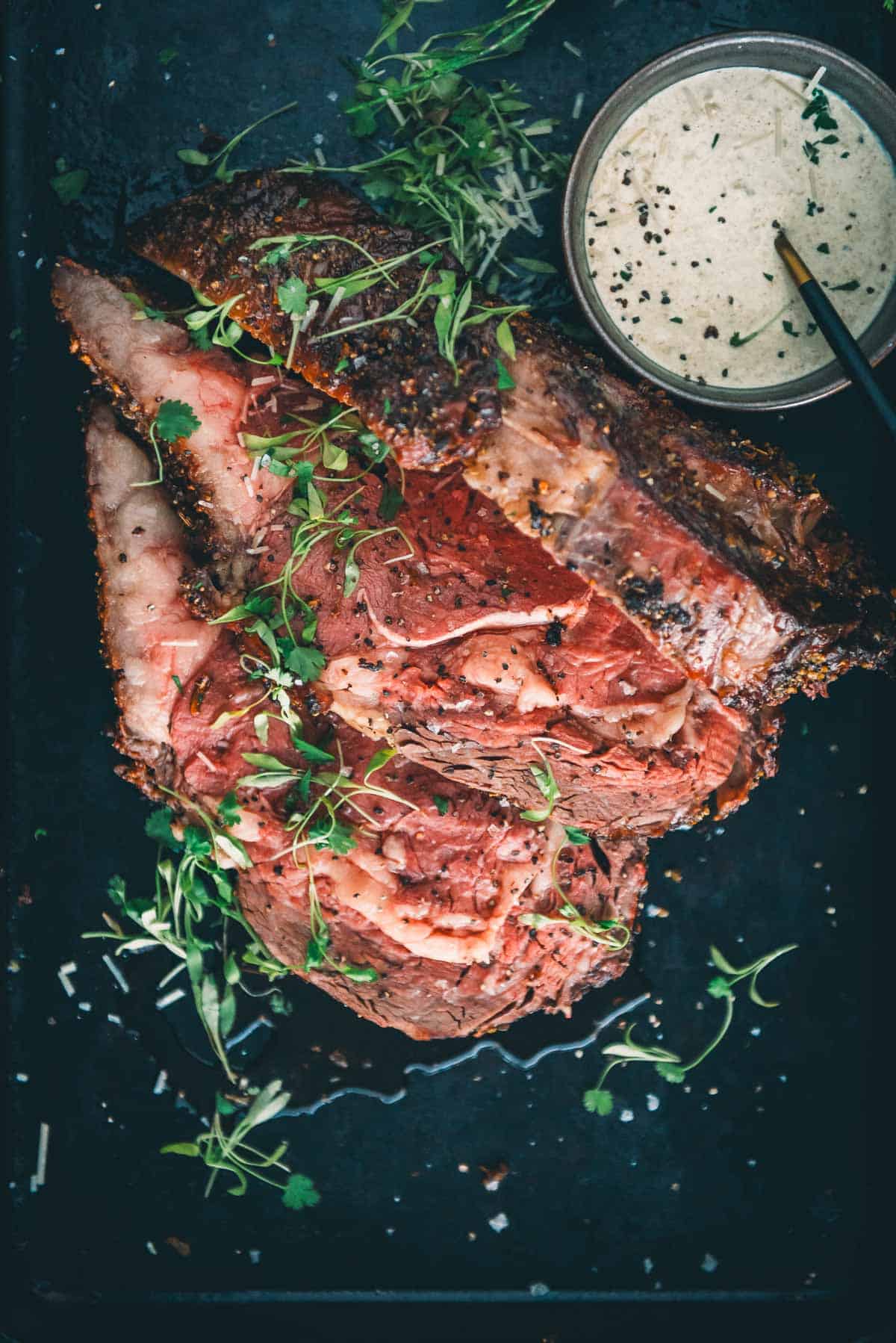
What to serve with a reverse seared prime rib
Pair this beef roast with hearty sides like creamy mac and cheese, luscious creamed spinach or leeks, a classic baked potato, cheesy brussels sprouts au gratin, and roasted green beans. Mix and match with all your favorite steakhouse side dishes.
Wine Pairing
Because this is essentially a big ribeye steak, pair this with a dry red wine. Go for a classic Cabernet Sauvignon, Malbec or Petit Syrah.
Storing and Reheating Leftover Reverse Sear Rib Roast
Wrap any leftover prime rib, with the juices, tightly in foil. Double wrap for an added layer of protection. And when cool, store it in the fridge for up to 3 days. Slice off what you need to reheat only individual portions. Reheat by quickly searing slices in a preheated skillet or slicing it up and using it in any recipe where beef can be used. Think prime rib tacos, steak and potato soup, salads, sandwiches, and the best egg scrambles.

More juicy Prime Rib Recipes
Beef Recipes
Smoked Prime Rib on a Gas Grill
Beef Recipes
Sous Vide Prime Rib with Au Jus
Beef Recipes
Garlic Herb Prime Rib
Beef Recipes
Smoked Prime Rib
Pulling this reverse-seared boneless rib roast off the grill and slicing into it is a showstopper moment your guests won’t forget. The ideal medium-rare interior with a gorgeous crust on the outside is so good this recipe never gets old. With this easy reverse sear prime rib recipe, you can confidently tackle this elegant roast and have it turn out tender and juicy, just like at a steakhouse.
Have you tried this recipe? Do us a favor and rate the recipe card with the ⭐ ⭐ ⭐ ⭐ ⭐ and drop a comment to help out the next reader.
Reverse Sear Prime Rib Recipe

Ingredients
- 4-5 lbs boneless rib roast a bone-in rib roast will work as well adjust cooking times for total weight
- 1 tbsp Kosher salt
- 2 tbsp Oil
- 3-4 tbsp Garlic seasoning we recommend Garlic Junkie by JewCanQue or Jack Daniel’s Steak Seasoning
Instructions
Prep the prime rib roast:
- Pat the 4-5 lbs boneless rib roast dry with paper towels. If the fat cap is thicker than 1/4 inch, score it with a sharp knife to help the salt permeate deeper.
- Liberally season all sides with 1 tbsp Kosher salt.
- Place on a wire rack over a rimmed baking sheet in the fridge for 24-48 hours.
Slow Roast the Prime Rib:
- When ready to cook, let the roast sit at room temperature for 1 -2 hours.
- Rub ll sides with 2 tbsp Oil and apple a liberal coating of the 3-4 tbsp Garlic seasoning.
- Meanwhile, prep your smoker for 250°F. See the notes instructions in an oven and for pellet, charcoal and wood suggestions.
- When the grill is preheated, place the boneless prime rib roast on the grill grates, fat side up, and close the lid.
- Smoke the roast for 60 minutes or until the internal temperature is 120°F with a digital meat thermometer, or about 15 degrees F below where your desired internal temperature is. Adjust the cooking time as needed for the weight of your roast.
Rest the prime rib:
- Using tongs, remove the roast from the grill grates and let it rest, tented with aluminum foil, on a rimmed baking sheet for 30 minutes. The internal temperature of the beef will continue to rise as it rests about 7 to 10 degrees.
- While the prime rib rests, increase the heat on the grill for a sear, getting the temp up to 450-500 degrees F.
Sear the roast:
- After the resting period, place a cast iron skillet on the hottest part of the grill and preheat it until just smoking.
- Using long tongs, add the roast to the hot skillet and sear for 3 to 5 minutes per side, getting a good golden brown crust on all sides.
Slice and serve:
- Transfer to a clean cutting board and wait 5 minutes before slicing into individual portions, about 1/2″ thick with a carving fork and sharp knife.
- Serve with a pinch of freshly ground black pepper, flakey salt, and homemade horseradish cream sauce or au jus.
Notes
- 135°F is the ideal internal temperature for a medium rare roast. Use a digital meat thermometer inserted into the thickest part of the rast for the most accurate results.
- If using a pellet smoker, try our favorite Jack Daniel’s charcoal pellets with chunks of oak or hickory in the back corners of your grill. We used our Traeger pellet grill for this boneless prime rib recipe.
HOW TO REVERSE SEAR A PRIME RIB USING THE OVEN:
Similar to our classic roasted prime rib roast, this recipe starts with low heat and adds a sear at the end.- Prep the roast as instructed in the recipe card, but when ready to cook, adjust the oven racks to the middle-low position to easily slide the roasting pan in and out. Then, preheat your oven temperature to 250 degrees F.
- After seasoning the roast, nestle it into a roasting rack and cook it until it registers 120°F with a meat thermometer.
- Rest it as instructed and sear it on all sides using a well-seasoned cast iron skillet on the range. After it’s seared on all sides for a perfect crust, slice and serve.
USING A GAS GRILL:
- If using a gas grill, follow the instructions as directed. But set up a two-zone fire in your grill to help keep an even heat. Preheat the grill by turning all of the burners on and cleaning your grill grates. Then, turn off two of the three (or three of the four) burners to create a hot side and a cool side. Adjust the heat as needed to preheat the grill to around 250°F with the lid closed. If smoking on a gas grill, add a smoker box while the grill preheats and be ready to replace the woodchips every 30 to 45 minutes.
- When ready to cook, place the roast on the cooler side of the grill until it reaches 120 degrees F, and then rest it for 30 minutes. Preheat a cast iron skillet over the hot side of the grill, increasing the heat to get the pan ripping hot. After the roast has rested, carefully sear it over direct heat to get a nice crust on all sides. Slice and serve your perfect reverse-seared prime rib.
USING A CHARCOAL GRILL:
- If using a charcoal grill, whether Kamado, drum or traditional kettle, prep the boneless rib roast as instructed. When ready to grill, build a two-zone fire by arranging lit charcoal on one side of the grill. If using smoking wood, add it to the coals now so it burns clean before adding the meat. Add the grill grate and adjust the air vents so the grill can maintain an even heat of around 250 degrees F.
- Smoke the roast until it reaches 120 degrees F, then while the roast rests for 30 minutes, add more fuel and/or adjust the vents to allow maximum air flow to get the grill up to 450 to 500 degrees. Preheat a cast iron skillet over the hot side of the grill and sear the roast on all sides before slicing and serving.
- We use Cowboy Brand hardwood lump charcoal or briquets when grilling for that real wood flavor.
Nutrition
Bookmark this recipe now!
